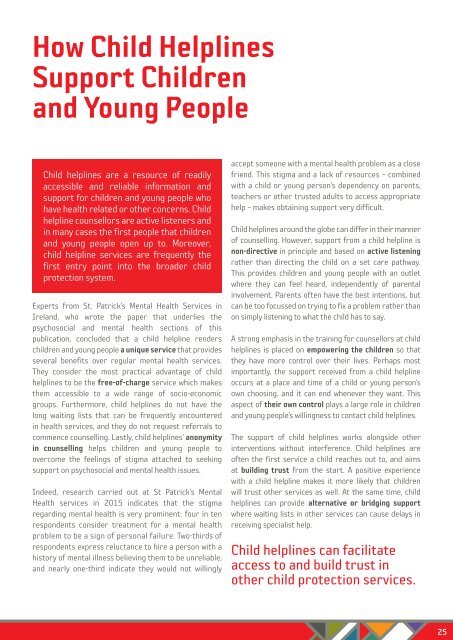The Voices of Children and Young People
FjLR300hYsM
FjLR300hYsM
Create successful ePaper yourself
Turn your PDF publications into a flip-book with our unique Google optimized e-Paper software.
How Child Helplines<br />
Support <strong>Children</strong><br />
<strong>and</strong> <strong>Young</strong> <strong>People</strong><br />
Child helplines are a resource <strong>of</strong> readily<br />
accessible <strong>and</strong> reliable information <strong>and</strong><br />
support for children <strong>and</strong> young people who<br />
have health related or other concerns. Child<br />
helpline counsellors are active listeners <strong>and</strong><br />
in many cases the first people that children<br />
<strong>and</strong> young people open up to. Moreover,<br />
child helpline services are frequently the<br />
first entry point into the broader child<br />
protection system.<br />
Experts from St. Patrick’s Mental Health Services in<br />
Irel<strong>and</strong>, who wrote the paper that underlies the<br />
psychosocial <strong>and</strong> mental health sections <strong>of</strong> this<br />
publication, concluded that a child helpline renders<br />
children <strong>and</strong> young people a unique service that provides<br />
several benefits over regular mental health services.<br />
<strong>The</strong>y consider the most practical advantage <strong>of</strong> child<br />
helplines to be the free-<strong>of</strong>-charge service which makes<br />
them accessible to a wide range <strong>of</strong> socio-economic<br />
groups. Furthermore, child helplines do not have the<br />
long waiting lists that can be frequently encountered<br />
in health services, <strong>and</strong> they do not request referrals to<br />
commence counselling. Lastly, child helplines’ anonymity<br />
in counselling helps children <strong>and</strong> young people to<br />
overcome the feelings <strong>of</strong> stigma attached to seeking<br />
support on psychosocial <strong>and</strong> mental health issues.<br />
Indeed, research carried out at St Patrick’s Mental<br />
Health services in 2015 indicates that the stigma<br />
regarding mental health is very prominent: four in ten<br />
respondents consider treatment for a mental health<br />
problem to be a sign <strong>of</strong> personal failure. Two-thirds <strong>of</strong><br />
respondents express reluctance to hire a person with a<br />
history <strong>of</strong> mental illness believing them to be unreliable,<br />
<strong>and</strong> nearly one-third indicate they would not willingly<br />
accept someone with a mental health problem as a close<br />
friend. This stigma <strong>and</strong> a lack <strong>of</strong> resources – combined<br />
with a child or young person’s dependency on parents,<br />
teachers or other trusted adults to access appropriate<br />
help – makes obtaining support very difficult.<br />
Child helplines around the globe can differ in their manner<br />
<strong>of</strong> counselling. However, support from a child helpline is<br />
non-directive in principle <strong>and</strong> based on active listening<br />
rather than directing the child on a set care pathway.<br />
This provides children <strong>and</strong> young people with an outlet<br />
where they can feel heard, independently <strong>of</strong> parental<br />
involvement. Parents <strong>of</strong>ten have the best intentions, but<br />
can be too focussed on trying to fix a problem rather than<br />
on simply listening to what the child has to say.<br />
A strong emphasis in the training for counsellors at child<br />
helplines is placed on empowering the children so that<br />
they have more control over their lives. Perhaps most<br />
importantly, the support received from a child helpline<br />
occurs at a place <strong>and</strong> time <strong>of</strong> a child or young person’s<br />
own choosing, <strong>and</strong> it can end whenever they want. This<br />
aspect <strong>of</strong> their own control plays a large role in children<br />
<strong>and</strong> young people’s willingness to contact child helplines.<br />
<strong>The</strong> support <strong>of</strong> child helplines works alongside other<br />
interventions without interference. Child helplines are<br />
<strong>of</strong>ten the first service a child reaches out to, <strong>and</strong> aims<br />
at building trust from the start. A positive experience<br />
with a child helpline makes it more likely that children<br />
will trust other services as well. At the same time, child<br />
helplines can provide alternative or bridging support<br />
where waiting lists in other services can cause delays in<br />
receiving specialist help.<br />
Child helplines can facilitate<br />
access to <strong>and</strong> build trust in<br />
other child protection services.<br />
25


